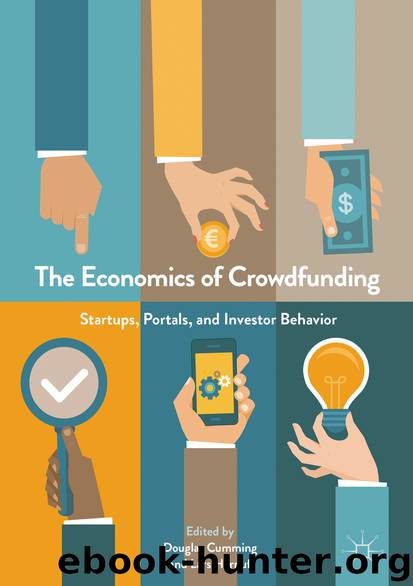The Economics of Crowdfunding by Douglas Cumming & Lars Hornuf

Author:Douglas Cumming & Lars Hornuf
Language: eng
Format: epub
Publisher: Springer International Publishing, Cham
7.3 Measuring Economic Impact
Projects therefore tend to deliver on their goals, but this does not mean that they lead to viable long-term impacts. I next examine this issue, which is complicated by the fact that Kickstarter projects span artistic and commercial ventures, and encompass a wide range of different goals, ambition levels, and expected outcomes. The first step in understanding the long-term impact of reward-based crowdfunding is to understand the variation among projects on Kickstarter. A logical way to do this would be to use the categories Kickstarter uses to define projects. However, these often span a wide range of project types—for example, the Design category includes both product design and architecture.
For this analysis, I have regrouped the categories somewhat to add clarity and to ensure that no one category makes up less than 2.5% of the total projects. The revised categories are based on the original categories in Kickstarter, with changes to rationalize and consolidate them. Unchanged from Kickstarter are the Games, Fashion, and Comics categories. Categories with minor variations include: Food (the same as the original, minus cookbooks and some gadgets), Technology (the same as the original, without makerspaces), and Film (the same as the original, without movie theaters). The Art category now includes projects in art, photography, graphic design, crafts, architecture, civic design, and typography. The Publishing category includes cookbooks and journalism, as well as the original publishing category. Dance and Theater are combined. Product Design only includes product design projects and unclassified design projects. Finally, I created a small category, Spaces, for projects supporting movie theaters, makerspaces, and practice spaces; however, due to its small size I exclude it from most further analyses.
We can further cluster these categories into two general groups: “product-oriented” and “art-oriented.” Examining all 11 of the newly defined categories by whether the goal of the creator was to create or sustain an organization, or else to launch a one-time project, the contrast between types of projects becomes clear. The five “product-oriented” categories are dominated by attempts to build organizations: three quarters or more of the projects in these categories are started by current or new formal organizations (mean = 0.84). On the other hand, the six “art-oriented” categories are generally created by one-time or informal groups, with less than half the projects involving organizations. Qualitatively, the artistic categories tend to also contain a higher proportion of purely creative projects, while the product categories are more likely to be commercial in nature (see Fig. 7.1).
Fig. 7.1What kind of organization created the project?
Download
This site does not store any files on its server. We only index and link to content provided by other sites. Please contact the content providers to delete copyright contents if any and email us, we'll remove relevant links or contents immediately.
The Black Swan by Nassim Nicholas Taleb(6763)
Bad Blood by John Carreyrou(6274)
Pioneering Portfolio Management by David F. Swensen(6078)
Millionaire: The Philanderer, Gambler, and Duelist Who Invented Modern Finance by Janet Gleeson(4093)
Skin in the Game by Nassim Nicholas Taleb(3965)
The Money Culture by Michael Lewis(3846)
Bullshit Jobs by David Graeber(3829)
Skin in the Game: Hidden Asymmetries in Daily Life by Nassim Nicholas Taleb(3722)
The Wisdom of Finance by Mihir Desai(3523)
Blockchain Basics by Daniel Drescher(3329)
Liar's Poker by Michael Lewis(3221)
The Intelligent Investor by Benjamin Graham Jason Zweig(2930)
Hands-On Machine Learning for Algorithmic Trading by Stefan Jansen(2925)
Mastering Bitcoin: Programming the Open Blockchain by Andreas M. Antonopoulos(2891)
Fooled by Randomness: The Hidden Role of Chance in Life and in the Markets by Nassim Nicholas Taleb(2860)
Investing For Dummies by Eric Tyson(2793)
The Power of Broke by Daymond John(2773)
Market Wizards by Jack D. Schwager(2538)
Zero Hour by Harry S. Dent Jr. & Andrew Pancholi(2533)
